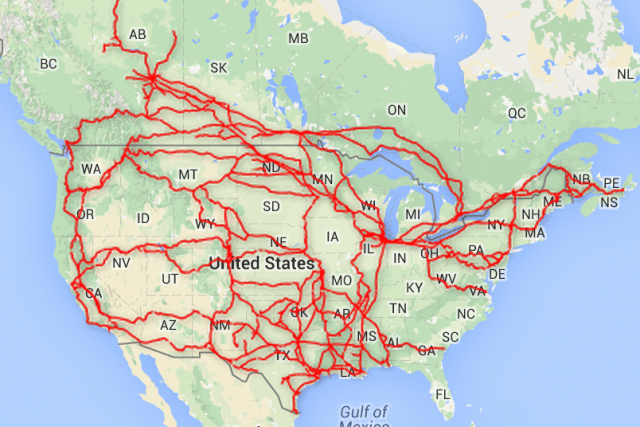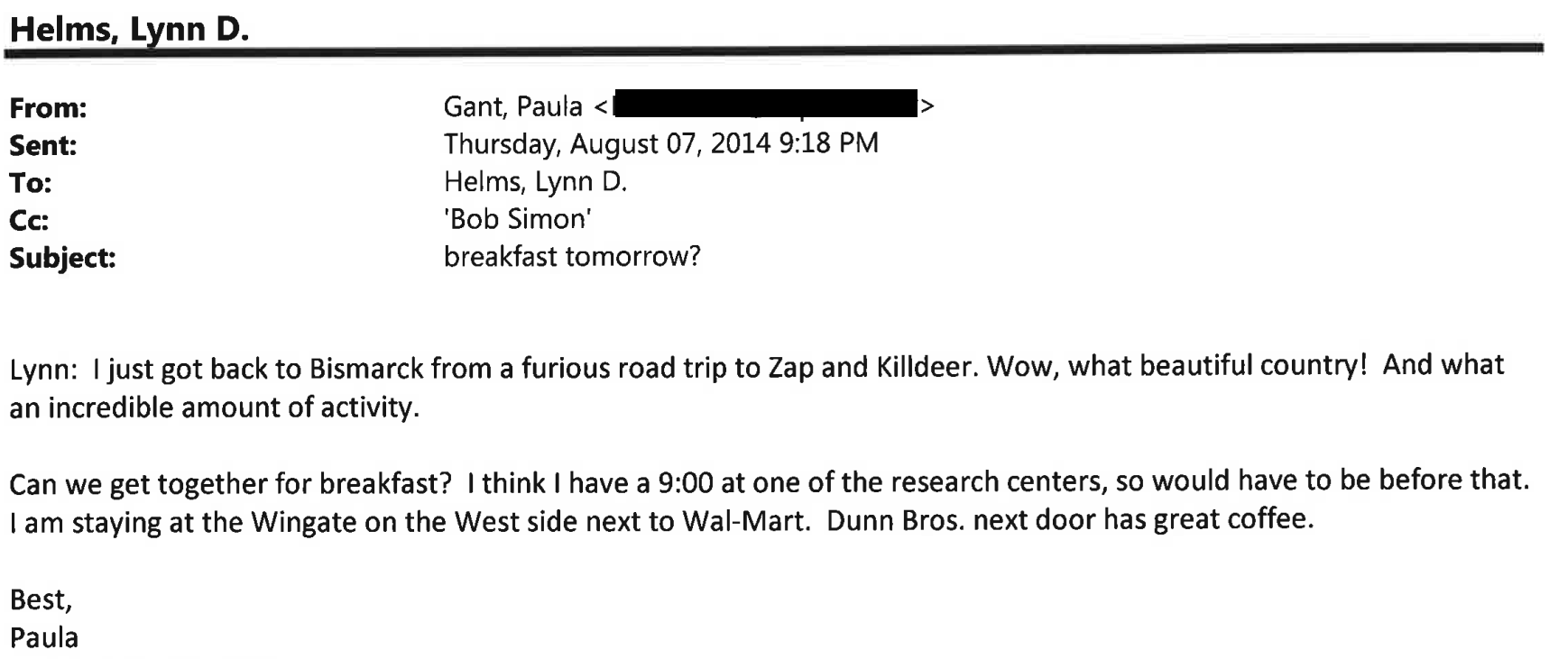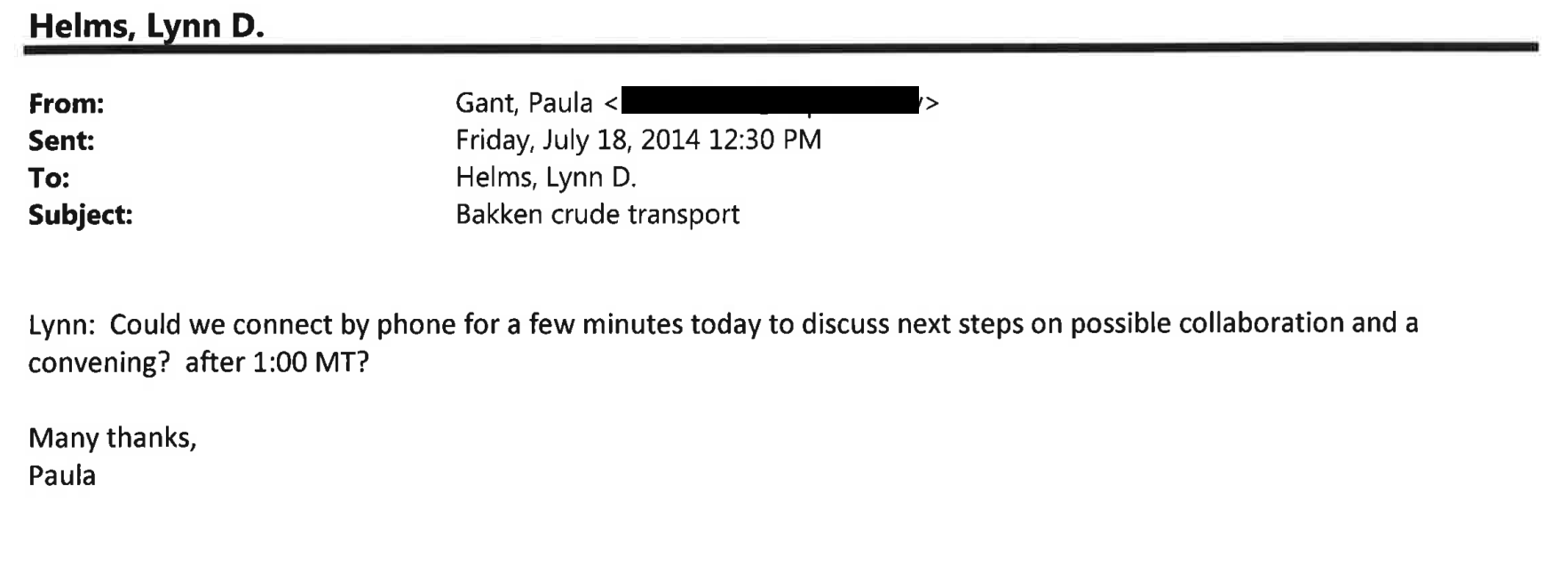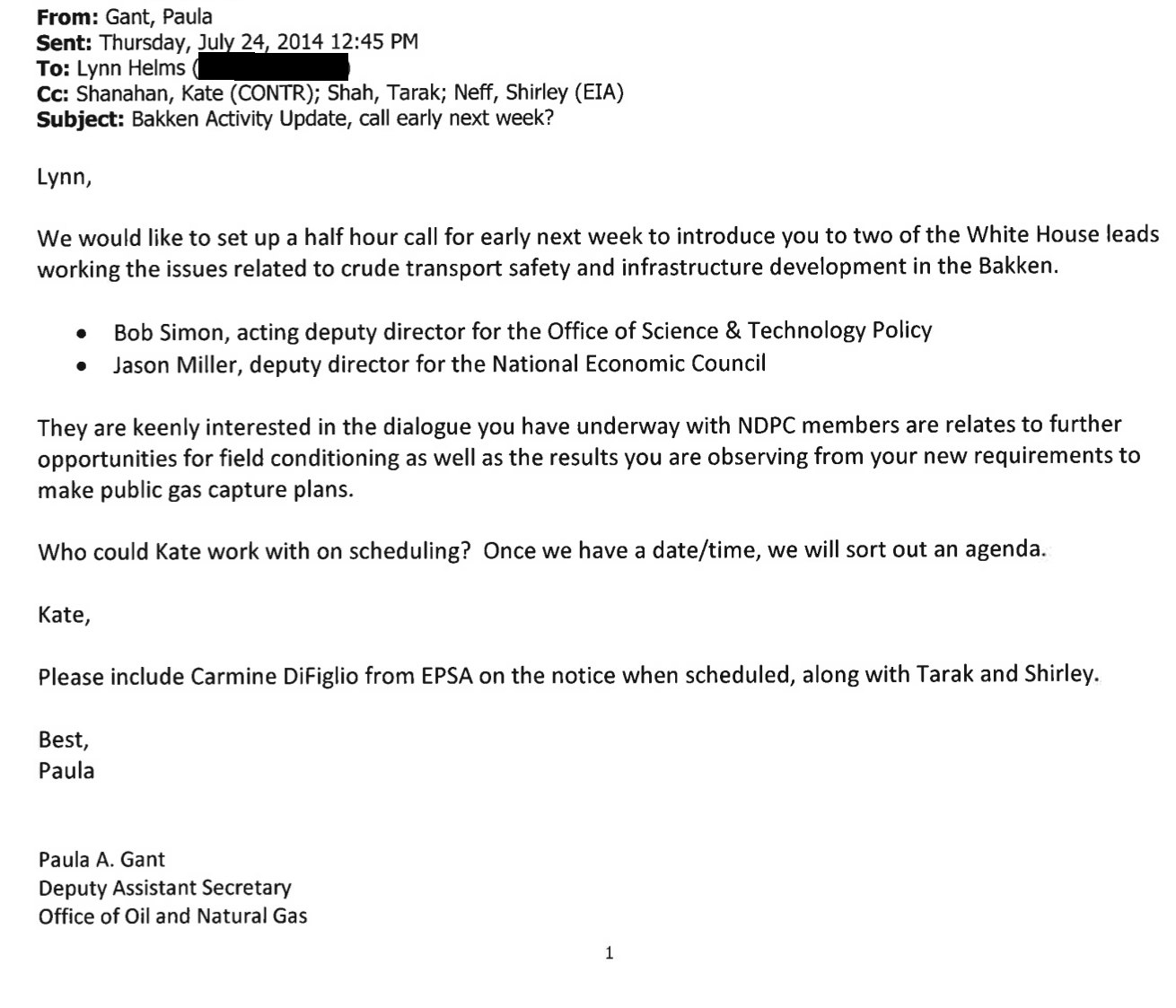A seemingly innocuous email about two people getting coffee in August of 2014 helps shed light on the behind-the-scenes lobbying efforts to shape the oil-by-rail regulations that have given the oil industry a pass on the explosive nature of Bakken crude oil.
The emails, acquired by DeSmogBlog via a Freedom of Information Act request, led us to discover a troubling trail of influence from the Beltway to the Bakken. It’s a sordid tale wherein public safety is needlessly compromised by the threat of “bomb trains” while the government ignores a simple fix to safeguard communities in favor of enabling runaway profits for the oil and rail industries.
Who is Paula Gant and why is she emailing Lynn Helms? And why did she copy Bob Simon about a coffee meeting she was having in North Dakota?
As previously covered by DeSmogBlog, Paula Gant worked as a high-ranking lobbyist first for Duke Energy and then for the American Gas Association before passing through the government-industry revolving door to become Deputy Assistant Secretary for Oil and Natural Gas in the Department of Energy’s Office of Fossil Energy.
Gant’s name also showed up on DeSmogBlog in an article about the Congressional Committee on Science, Space and Technology’s hearing on the explosive properties of Bakken crude oil. In that hearing, climate science-denying Rep. Paul Broun (R-Ga.) put on a real show about how disappointed he was that the Obama administration refused to send him the expert witnesses he requested to testify about the volatility of Bakken crude.
While I look forward to hearing from both panels today, I must say I am disappointed — though not surprised — at this Administration’s continued unwillingness to work with the Congress. Chairman Lummis and I invited representatives from the agencies who are experts in the subject matter because we are interested in the science behind Bakken crude.
When DeSmogBlog contacted Broun’s office to ask who his preferred expert witnesses were, one of the two names was Dr. Paula Gant. (The actual witness at the hearing was Gant’s boss). As we noted at the time, Gant was an odd choice to be considered an expert witness on the topic of Bakken oil since she has an economics degree.
And now the recently released report, Literature Survey of Crude Oil Properties Relevant to Handling and Fire Safety in Transport, appears on a DOE web page with Paula Gant’s name listed right next to it.
Gant’s name appeared frequently in the Freedom of Information request DeSmogBlog made to the North Dakota Industrial Commission (NDIC), the governing body that has authority to regulate the North Dakota oil industry. NDIC chose to not require oil stabilization in the new regulations that went into effect on April 1st in North Dakota.
Gant had multiple exchanges with Lynn Helms about Bakken crude.
Lynn Helms is Director of the Department of Mineral Resources and described himself as “the primary contact for Governor Dalrymple’s team on the crude safety issue” in one email exchange. Prior to his current job as oil industry regulator, Helms worked for oil companies Texaco and Hess. Hess is one of the top oil producers in the Bakken.
Interestingly enough, Helms recently approved a plan for Hess to drill in the Killdeer Mountains — the range Gant referred to as “beautiful country” with “an incredible amount of activity” in her email requesting a breakfast meeting with Helms.
Prior to the “great coffee” meeting email, on July 18th 2014, Gant emailed Helms with the subject line “Bakken crude transport” seeking to “discuss next steps on possible collaboration.”
The following week, on July 24, Gant sent another email introducing Helms to two new players from the White House whom she described as “keenly interested” in this issue.
The timing of this introduction of the White House into the discussion is interesting because it came the day after the new federal proposed regulations on oil-by-rail transportation were released. The regulations included no proposal to require stabilization of the oil.
Recently Reuters reported that the White House was directly involved in making sure the DOT regulations did not require stabilization and instead supported “treatment of crude oil in the field” which would appear to be in line with Gant’s email reference to “further opportunities for field conditioning.”
“Before the meeting, the department had already identified issues with the characteristics of the crude oil, including vapor pressure, and had developed potential strategies related to the overall improvement and safety of the transport of the product and how the industry could treat it,” the White House official said.
But after the meeting with the White House officials, Reuters reported the DOT no longer was interested in addressing vapor pressure in crude oil. “The Department of Transportation supported North Dakota on treatment of crude oil in the field,” Reuters reported.
The two White House officials who were “keenly interested” in “further opportunities for field conditioning” and were copied on Gant’s email were Bob Simon, currently a consultant to the Office of Science and Technology, Executive Office of the President and Jason Miller, Special Assistant to the President.
Simon has a long career in energy legislation and has held multiple high level staff positions in the Senate related to energy and, unlike most people in D.C., he has a PhD in inorganic chemistry from the Massachusetts Institute of Technology, so the odds are good that he understands the science being discussed.
And yet, the regulations that resulted from the DOE and the White House directly collaborating with Lynn Helms are widely considered useless when it comes to reducing the volatility, vapor pressure and danger of Bakken crude. The new regulations only require field conditioning, a process that isn’t designed to reduce the volatility or vapor pressure of crude oil.
The fact that existing regulations are not sufficient has been acknowledged in the recently introduced Crude-By-Rail Safety Act of 2015. As co-sponsor Sen. Maria Cantwell’s (D-WA) press release noted, “The Crude-By-Rail Safety Act of 2015 requires the Pipeline and Hazardous Materials Safety Administration (PHMSA) to draft new regulations to mitigate the volatility of gases in crude oil shipped via tank car.”
An interesting note: there were no email communications provided in response to our FOIA request involving DOT or PHMSA staff communicating with North Dakota regulators. The discussions were only happening with DOE and White House staff members, not the agency actually in charge of regulating oil-by-rail.
Sandia National Laboratories
So despite not having regulatory authority over oil-by-rail, the Department of Energy has been quite involved in the issue and went so far as to sponsor the recently released report by Sandia National Laboratories.
So what did the new study by Sandia National Laboratories conclude about Bakken oil?
Essentially nothing, and that more research was required to understand Bakken oil. The study did cite serious issues with existing sampling techniques, oil classification and described the one industry-funded study it reviewed as having “fundamental limitations” which “makes the report somewhat anecdotal.”
The Sandia report does nothing to advance the discussion about why Bakken oil trains are blowing up or how to prevent explosive bomb trains in the future, thus delaying any regulations to address the issue.
Bomb Trains Roll On, Government Asleep at the Switch
With seven Bakken oil train crashes all resulting in dangerous fireballs and explosions, it would seem that anyone actually interested in addressing the issue of how to prevent this would have commissioned a study with a different objective.
The government could have also found an objective contractor to conduct this study, as Sandia might not be the most impartial player. As noted in the report, Sandia “is a multi-program laboratory managed and operated by Sandia Corporation, a wholly owned subsidiary of Lockheed Martin Corporation.
Lockheed Martin has recently expressed interest in growing its oil and gas industry business. So producing a report that was immediately embraced by the American Petroleum Institute (API), might be seen as a wise business move.
As noted on DeSmogBlog, this report was also cited by two congressman using API talking points in a recent hearing on oil-by-rail safety as “proof” that the volatility of Bakken oil was not a safety issue.
Sandia doesn’t have a great recent track record of staying impartial and independent. In November of 2014, a Department of Energy Inspector General report found that Lockheed had illegally lobbied to get a no-bid contract extension to manage the lab, as reported by the Albuquerque Journal.
…a report by the Department of Energy’s Office of Inspector General concluded that Lockheed Martin wrongfully used federal funding provided to Sandia for lab operations to pull the strings of power and lobby for the no-bid contract extension it ultimately received
And this isn’t the first time it happened:
Wednesday’s report comes after a 2013 inspector general’s report that alleged Sandia had inappropriately paid former Rep. Heather Wilson, R-N.M., about $226,000 in consulting fees, beginning in January 2009, to lobby for Sandia to take on new assignments for the federal government
Sandia also made the news recently as the company working with the Central Intelligence Agency to try to hack Apple’s encryption.
Another Sandia connection appears on Bob Simon’s LinkedIn page where he is endorsed by Michael Cieslak, Director Emeritus at Sandia National Laboratories. Simon and Cieslak worked together in the U.S. Senate and Cieslak says, “Bob is an extremely high integrity executive and has had experience negotiating energy and environmental policy decisions at the highest levels of the federal government.”
It would appear that there are few people more experienced in negotiating energy policy than Bob Simon.
Did the White House instruct the DOT not to include any stabilization requirements in the federal oil-by-rail regulations? On the day after the proposed regulations were released, did the White House deploy Bob Simon to get involved in the North Dakota regulation discussion? Clearly. Did they get exactly what they wanted in North Dakota as a result?
Science of Bakken Volatility Can’t Be Faked or Ignored
To date, all efforts to avoid stabilization of Bakken crude oil have been successful, favoring industry profits over public safety.
And this new DOE report has only provided the American Petroleum Institute more ammunition for their argument… as long as you don’t bother to read the whole thing.
Buried in the report is something that has been known only to those paying careful attention.
Conditioning of oil, which is what the current North Dakota regulations require, does not remove the natural gas liquids that make the oil more volatile and flammable. Only stabilization does that.
For anyone looking to address how to make Bakken crude oil transport safer, this would appear to be the key takeaway from the report. But it is clear this was not the purpose of this report.
On page 29 there is a section titled “Stabilization vs. Conditioning.”
The purpose of conditioning is to remove impurities from crude oil with the intent to eliminate compounds (typically nonhydrocarbon compounds) from the oil that lack fuel value or that unnecessarily elevate the hazard level of the petroleum, e.g., presence of toxic hydrogen sulfide. The principal purpose of stabilization, in contrast to conditioning, is to remove hydrocarbon compounds—which possess fuel value, but which also possess higher vapor pressures (i.e., have lower boiling points)—so as to reduce the volatility of the crude oil.
Conditioning isn’t designed to remove the natural gas liquids or remove vapor pressure. That is what stabilization does. However, the report mentioned that stabilization requires a much more involved process and equipment — or, as the industry sees it, more costs of doing business that impact profit.
But, we knew this since it was also buried in one of the industry-funded reports, as we noted on DeSmog in September 2014.
The data consistency [sic] indicates that field equipment is limited in its ability to significantly impact vapor pressure and light ends content.
This is consistent with the expected capabilities of the equipment.
The field equipment is designed to separate gas, remove water and break emulsions to prepare crude for transport, and not remove significant levels of dissolved light ends from the crude.
According to the July 29 meeting minutes — less than a week after the new proposed DOT regulations ignored the issue of stabilization, and after being in communication with Paula Gant — Lynn Helms explained why oil conditioning was the preferred method.
“In response to a question regarding other mechanisms besides oil conditioning in the field, Mr. Helms stated there are other mechanisms — none of them without a significant downside….It makes sense to do the conditioning in the field. There are other options to do it downstream somewhere in a very large and very expensive operation.”
Stabilization is known to work to reduce vapor pressure and to remove natural gas liquids — something conditioning doesn’t do.
But conditioning equipment is already in use in the field and stabilization equipment would require the industry to buy new equipment.
And, as Lynn Helms explained, that is a significant downside, so the industry has refused to do it.
In hindsight it would appear that the Reuters report that the White House decided to let North Dakota handle the situation with oil conditioning wasn’t quite accurate. The White House was directly involved with Bob Simon and Paula Gant collaborating with Lynn Helms.
In the end, the oil industry got exactly what it wanted. And the bomb trains continue to roll on through major cities and right past the homes of millions of Americans.
Subscribe to our newsletter
Stay up to date with DeSmog news and alerts











